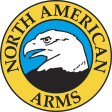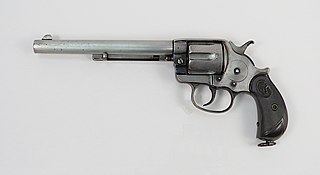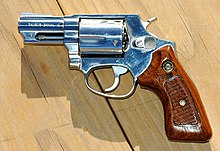
A revolver is a repeating handgun that has at least one barrel and uses a revolving cylinder containing multiple chambers for firing. Because most revolver models hold up to six cartridges before needing to be reloaded, revolvers are also commonly called six shooters.

A derringer is a small handgun that is neither a revolver nor a semi/fully automatic pistol. It is not to be confused with mini-revolvers or pocket pistols, although some later derringers were manufactured with the pepperbox configuration. The modern derringer is often multi-barreled, and is generally the smallest usable handgun of any given caliber and barrel length due to the lack of a moving action, which takes up more space behind the barrel. It is frequently used by women because it is easily concealable in a purse or a stocking.

A semi-automatic pistol is a handgun that automatically ejects and loads cartridges in its chamber after every shot fired. Only one round of ammunition is fired each time the trigger is pulled, as the pistol's fire control group disconnects the trigger mechanism from the firing pin/striker until the trigger has been released and reset.

The Colt Single Action Army is a single-action revolver handgun. It was designed for the U.S. government service revolver trials of 1872 by Colt's Patent Firearms Manufacturing Company and was adopted as the standard-issued pistol of the U.S. Army from 1873 until 1892.

The .410 calibre is one of the smallest caliber of shotgun shell commonly available. A .410 bore shotgun loaded with shot shells is well suited for small game hunting and pest control. The .410 started off in the UK as a garden gun along with the .360 and the No. 3 bore rimfire, No. 2 bore rimfire, and No. 1 bore rimfire. .410 shells have similar base dimensions to the .45 Colt cartridge, allowing many single-shot firearms, as well as some derringers and revolvers chambered in that caliber, to fire .410 shot shells without any modifications.

Taurus Armas S.A. is a Brazilian manufacturing conglomerate based in São Leopoldo, Rio Grande do Sul, Brazil. Founded in 1924 as a tool and die forging plant, the company now consists of Taurus Armas, its firearm division, as well as other divisions focusing on metals manufacturing, plastics, body armors, helmets and civil construction.

In American English, a pocket pistol is any small, pocket-sized semi-automatic pistol, and is suitable for concealed carry in either a coat, jacket, or trouser pocket.

A trigger is a mechanism that actuates the function of a ranged weapon such as a firearm, airgun, crossbow, or speargun. The word may also be used to describe a switch that initiates the operation of other non-shooting devices such as a trap, a power tool, or a quick release. A small amount of energy applied to the trigger leads to the release of much more energy.

North American Arms is a United States company, headquartered in Provo, Utah, that manufactures pocket pistols and mini-revolvers, also called mouse guns. The company was originally named Rocky Mountain Arms when it was founded in 1972. In 1974 it was bought by new owners who renamed the company North American Manufacturing (NAM) and then North American Arms (NAA).

A snubnosed revolver is a small, medium, or large frame revolver with a short barrel, generally less than 4 inches in length. Smaller such revolvers are often made with "bobbed" or "shrouded" hammers and there are also "hammerless" models ; the point is to allow the gun to be drawn with little risk of it snagging on clothing. Since the external movement of the mechanism is minimal or nil, shrouded and hammerless models may be fired from within clothing. The design of these revolvers compromises range and accuracy at a distance in favor of maneuverability and ease of carry and concealment.

S&W Centennial is a family of revolvers made by Smith & Wesson on the "J-Frame". Depending upon caliber, the cylinder holds either 5, 6, 7, or 8 cartridges. Centennials feature a fully enclosed (internal) hammer, which makes them Double Action Only (DAO) firearms. Like all other "J-frame" Smith & Wesson revolvers, they have a swing-out cylinder. Centennial models have been made in different versions like PD "Personal Defense", LS "Lady Smith", and M&P "Military & Police"

A handgun is a short-barrelled gun, typically a firearm, that is designed to be usable with only one hand. It is distinguished from a long gun, which needs to be held by both hands and also braced against the shoulder to be used properly. The two most common types of handguns in modern times are revolvers and semi-automatic pistols, although other types such as derringers and machine pistols also see infrequent usage.
The .327 Federal Magnum is a cartridge introduced by Federal Premium Ammunition and also sold by Sturm, Ruger & Co. It is intended to provide the power of a .357 Magnum in six-shot, compact revolvers, whose cylinders would otherwise only hold five rounds. The .327 has also been used in full-sized revolvers with a capacity of seven rounds or more.

The Taurus Judge is a five shot revolver designed and produced by Taurus International, chambered for .410 bore shot shells and the .45 Colt cartridge. Taurus promotes the Judge as a self-defense tool against carjacking and for home protection.

The Chiappa Rhino is a revolver produced by Italian manufacturer Chiappa Firearms. The Rhino's frame is CNC-machined from a solid block of high-tensile aluminium alloy and all internal parts are CNC-machined from steel.
The Taurus Model 731 is a stainless steel, double-action, six-shot, snubnosed revolver chambered in .32 H&R Magnum. The revolver has rubber grips and features an integral keylock.

The Colt M1878 is a double-action revolver that was manufactured by Colt's Manufacturing Company from 1878 to 1907. It is often referred to as the "Frontier" or the "Double Action Army" revolver. A total of 51,210 Model 1878 revolvers were manufactured from 1878 to 1907, including 4,600 for the US Ordnance Department. These are known as the "Philippine" or "Alaskan" models.
The Taurus Model 617 is a double-action, seven-shot, snubnosed revolver chambered in .357 Magnum, with a 2" barrel. It is offered in stainless steel and was formerly available blued. A Titanium model was available but has since been discontinued. It features an exposed hammer. Like many Taurus revolvers, it features an integral keylock. It can be fired both in Single-action and Double-action.

In firearms, a safety or safety catch is a mechanism used to help prevent the accidental discharge of a firearm, helping to ensure safer handling.

Richard J. Casull was a Salt Lake City-born gunsmith and wildcat cartridge developer whose experiments with .45 Colt ammunition in the 1950s led to the creation of the .454 Casull cartridge. Casull's passion was six-shooters, and he was determined to create a high velocity round for the .45 Colt. His goal was to achieve a muzzle velocity of 2,000 feet per second with Colt .45 rounds fired from a single-action Army-style revolver with a 7+1⁄2inch barrel. This proved impossible due to the tensile strength of the Colt .45 cylinder, so he set out to develop his own casing and bullet.




















